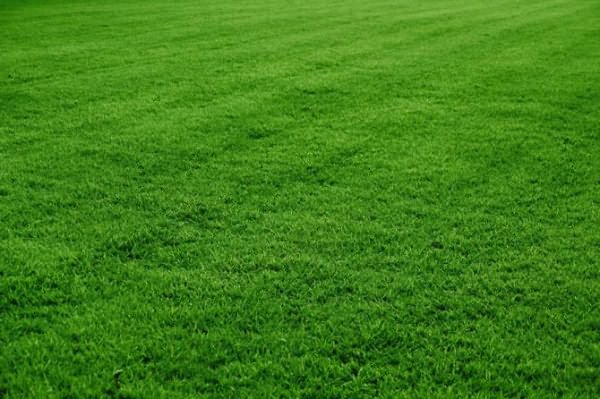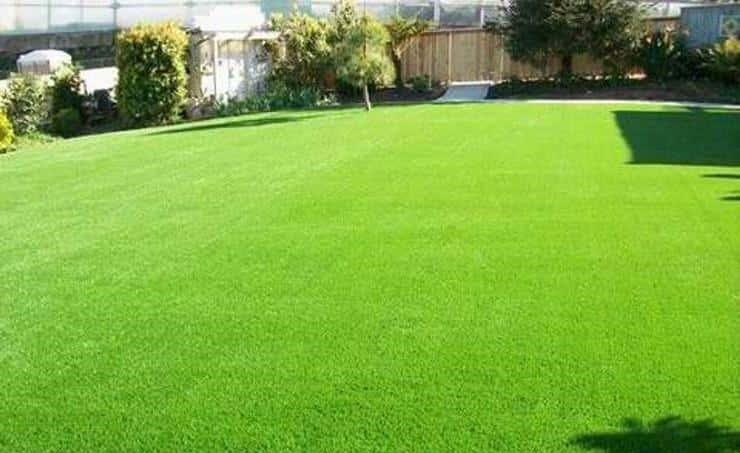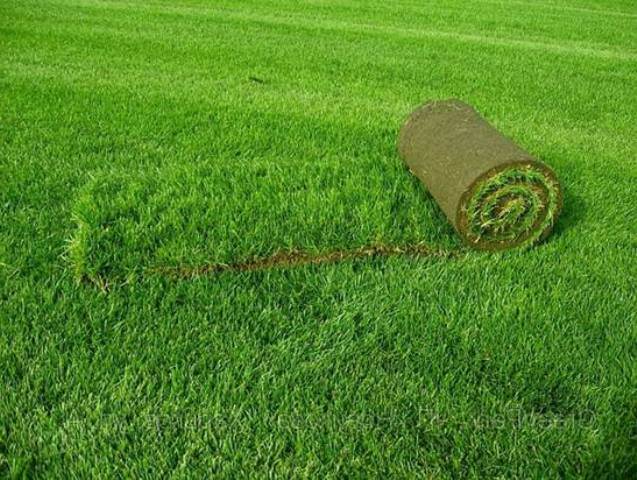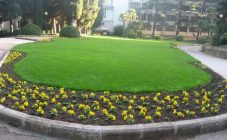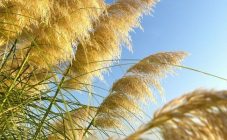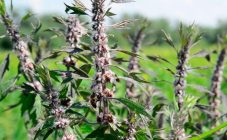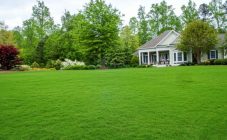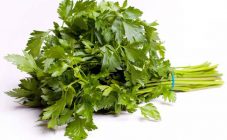Content:
Green grass lawns are a necessary component of landscape design. Perennial cover is often created from undersized plants that do not require cutting. This significantly increases the life of the coating. But for the correct operation of the decorated areas, it is necessary to select herbs that can satisfy the requirements set by the consumer.
Some information about plants
Low-growing lawn grass, which is used to decorate various sites, is selected from such types as:
- escaping bent leaves, allowing to exclude haircut;
- meadow bluegrass, the most beautiful of these herbs;
- pasture ryegrass, which is used to create a temporary (for 12 months) lawn;
- clover variety with white flowers;
- hairy and red fescue, which can be planted under a tree, as they tolerate shade well.
Various combinations of the described plants are used to produce lawn coverings. For the laziest consumers, you can choose a low type of grass that does not need to be cut more than 1 time a year. If the store does not have the desired composition, then you can do it yourself, having previously purchased the appropriate seeds. But first you need to find out the properties of the plants used for arranging lawns, otherwise all the work will go down the drain.
Types of lawn grass
Low-growing lawn grass that does not require cutting should be soft to the touch, pleasant and delicate. You can walk on it barefoot. These are the qualities that various greens have.
For these purposes, the escaping role is often used. She has the following parameters:
- the height of the bushes ranges from 5 to 12 cm;
- the plant quickly releases roots, and then grows over the entire area provided;
- during the season, the bushes are cut no more than 3-4 times, and they are fed 2 times;
- the green carpet of bent grass is not trampled under the influence of people walking on the lawn;
- it grows well in any soil, easily develops in partial shade.
Another candidate for a low-growing lawn is meadow bluegrass.
It has the following parameters:
- beautiful view;
- the height of the bushes reaches 10 cm;
- able to grow vertically upward, like a pile on a carpet;
- after hibernation, wakes up faster than other plants;
- the grass cover remains green all year round;
- during drought, the plant "falls asleep", but with the first rain it is completely restored;
- the area with bluegrass does not require special care: you need to mow the lawn once a year due to the slow growth of the grass.
There are also disadvantages of culture: planting needs to be weeded. The plant is often used to cover football fields, as it is cut only 1-2 times a year.
The short clover has the following technical data:
- he practically does not need a haircut;
- culture spreads along the ground;
- clover completely takes up all the free space;
- blooms 2 times a year;
- with its help they make a roll type of lawn coverings;
- clover does not require fertilizing and frequent watering.
The disadvantages of clover are:
- its slipperiness after rain or watering;
- a cluster of dried flowers.
If you need to create a temporary lawn for the holiday, then pasture ryegrass is the most profitable representative of the flora. It has the following properties:
- the plant quickly fills the territory allocated to it;
- forms lush bushes due to the presence of many processes on the stem;
- its root structure contributes to a strong lawn;
- the first year you do not need to mow the grass, since it has too little height;
- ryegrass tolerates trampling well, easily recovers from damage;
- the plant often suffers from spring night frosts;
- if the winter is not very snowy, then the bushes can withstand average values of cold;
- he loves to grow in open areas, but he can calmly develop in the shade;
- ryegrass needs fertile soil, so it is given more fertilizer than other types of lawn plants;
- watering the bushes requires surface irrigation;
- ryegrass is prettier than other herbs, but falls off quickly, therefore it is used no more than 12 months
Manufacturers offer plain red fescue for lawn lovers. She has the following parameters:
- in the first year, it reaches a height of no more than 10-20 mm, but then quickly grows to 8-10 cm;
- this herb is not trampled down, therefore it is used when creating playgrounds;
- the dwarf lawn created with this grass looks like a fluffy rug;
- extreme heat can destroy the fescue lawn;
- the plant feels good both in the shade and in open areas.
If you need to create a dwarf lawn, then use hair-like fescue. It is a short, slow-growing plant that looks like a wire sticking upwards - the ideal lawn grass that does not require cutting. Hairy fescue can tolerate heat and drought and can be grown on any soil, as well as along roads that are sprinkled with salt in winter. The grass can be shaded, planted in low light. The disadvantage of this variety is the need to use high-quality fertilizers, otherwise the hair fescue will not germinate.
To create a fast-growing lawn that is unpretentious in maintenance, use the following plants or their mixtures:
- Clover and field grass. Manufacturers produce roll coverings with these components for decorating areas in front of estates.
- If it is necessary to create small temporary landscaping zones, ryegrass and metlik are most often used. But it must be borne in mind that in extreme heat, the first component can burn out, leaving bald spots on the decorated area.
- Hair fescue and the Lilliputian and Moorish style roll lawns created on its basis. Such a low-growing lawn serves for several years practically without maintenance, although it requires watering.
For lazy customers, these options are the best as they are based on grass that does not need to be mowed more than 1-2 times a year.
Dwarf lawn: growing and care
The grower selects the right seeds and then selects the soil based on the composition of the grasses sown. For most plants, it is best to find low-lying areas where groundwater is suitable. The soil is dug up, and then fertilizers are applied to it, for example, superphosphate. If the soil has a high acidity, then it is brought to the desired condition by pouring lime and wood ash into the soil.
Sowing can be carried out with seeds or order rolls with seedlings already inserted into them to the required depth. If there is a ready-made material, it is simply placed in the allocated place. If the seed fund is to be used, then individual seeds are placed at a depth of 15-20 mm in pre-dug holes. Up to 30 g of material is used per 1 m².
After about 5 days, the first shoots will appear. They do not need to be watered until several leaves develop on each bush.If it is sultry, hot weather, it is recommended to irrigate the seedlings with warm water that has been set in the sun. Caring for sprouted grass requires proper watering (many plants love moisture). In addition, fertilizers must be applied to the soil 1-2 times a season. You can use both organic (diluted in water manure) and mineral mixtures containing calcium, phosphorus and nitrogen.
Although all of the herbs described are weeds, fungi or soil bacteria can make them sick. To prevent this from happening, it is recommended to treat them once a year with appropriate medicines or folk remedies (soapy water). When insects appear that eat lawn grasses, it is recommended to destroy them with special means.
Tips for choosing grass for the site
To get a lawn that does not need to be mowed, it is recommended to determine exactly what type of lawn the consumer wants to get. There are 2 types of such coatings:
- park option;
- meadow lawn.
The first type of lawn consists of a mixture of broom, fescue (20% by volume), bent grass and ryegrass (30% each). For the park, you can use another composition: 15% bent grass, 60% ryegrass, 25% fescue. Low-growing lawn grass for meadow cover consists of mixed plants - wheatgrass and metlik.
To create a composition, you can immediately order roll views, where everything has already been taken into account. They are placed in the right places, watered, fertilized. If the gardener decided to sow the seeds himself, then he should ask about the depth of their laying in the ground, the necessary composition of the soil, and measures for caring for the grown plants.
It is rather difficult to choose a grass covering suitable for the estate on your own. Therefore, it is better to turn to specialists who will help you cope with the task. Any novice gardener can sow the prepared areas. If everything is done correctly, then in about a month the result will be visible.
